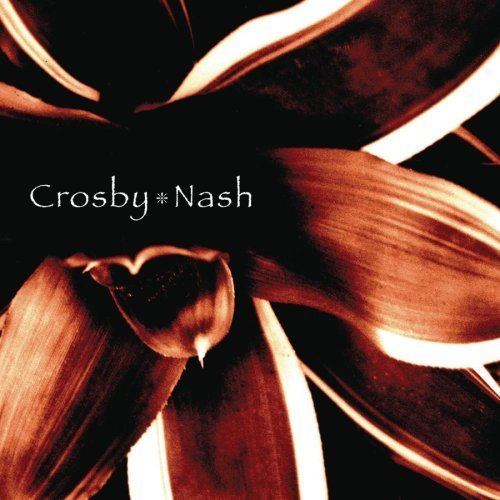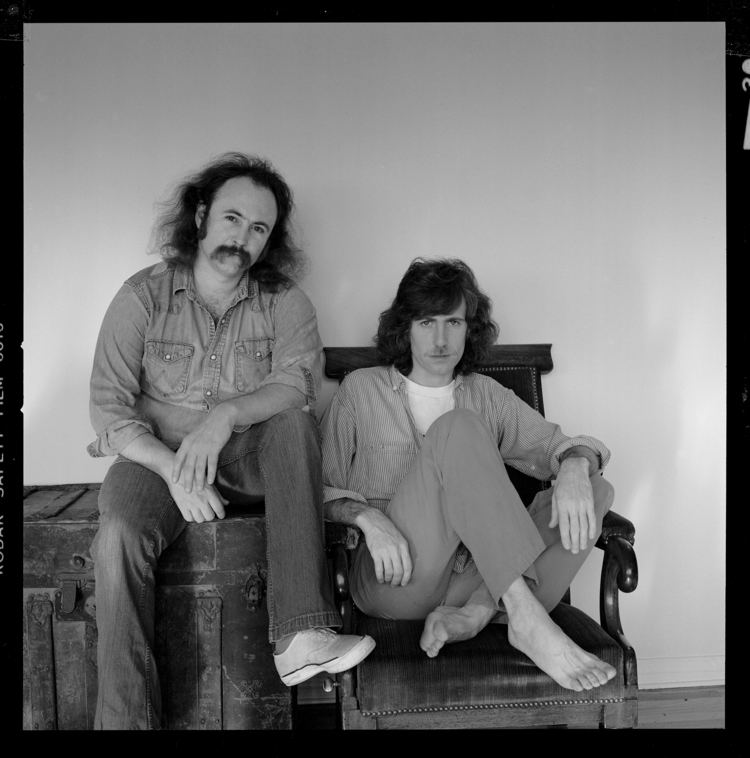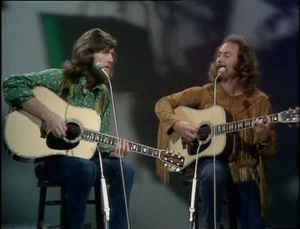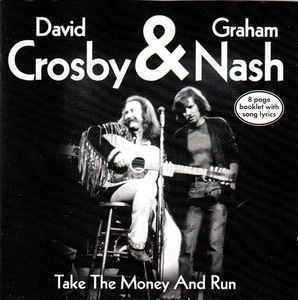Years active 1970–2016 Members David Crosby, Graham Nash | Website www.crosbynash.com Genres Rock music, Folk rock | |
 | ||
Labels Atlantic, ABC, Arista, Sanctuary Associated acts Crosby, Stills, Nash & Young, CPR, The Hollies, The Byrds Past members David Crosby
Graham Nash Origin Los Angeles, California, United States Albums Graham Nash David Cr, Wind on the Water, Whistling Down the Wire, Another Stoney Evening, The Best of Crosby & Nash: Th | ||
In addition to solo careers and within the larger aggregate of Crosby, Stills, Nash & Young, the musical team of David Crosby and Graham Nash have performed and recorded regularly as a duo, mostly during the 1970s and the 2000s.
Contents

History

After the success of Déjà Vu and the subsequent break-up of the quartet in the summer of 1970, all four members of CSNY released solo albums. Crosby's If I Could Only Remember My Name and Nash's Songs for Beginners appeared in 1971 and missed the top ten. That autumn, the two good friends toured together as an acoustic duo to favorable reviews; one night from this tour would be released twenty-seven years later as Another Stoney Evening. In 1972 the two decided to record an album, resulting in Graham Nash David Crosby, which reached #4 on the Billboard 200, demonstrating that the two were still a viable draw without the more successful Stills and Young. Further work together later in 1972 was precluded by Crosby's participation in The Byrds' reunion album recording sessions. In 1973, the pair joined Neil Young for the tour that would result in his Time Fades Away album, Crosby collaborated with electronica artist and Grateful Dead associate Ned Lagin, and Nash recorded a second solo album, Wild Tales. During this time, singularly and together they contributed backing vocals to various albums by associates in the California rock scene, including Stephen Stills, Harvest, Late for the Sky, and Court and Spark.

In 1974, both dutifully joined the Crosby, Stills, Nash & Young reunion tour and an attempt at the recording of a new album in Hawaii, sessions for which had continued in fits and starts after commencing in late 1973. After failing to complete an album, Crosby and Nash signed a contract with ABC Records. Presumably for contractual obligations to their old label, the cassette and 8-track tape versions of their ABC LPs were issued by Atlantic. Recording activity yielded two albums in 1975 and 1976 respectively, Wind on the Water and Whistling Down the Wire. In that bicentennial year, Stephen Stills and Neil Young invited the duo to a recording session for their album Long May You Run. Crosby and Nash were forced to leave the recording session because they had time constraints to complete their second album for ABC Records, so Stills and Young wiped their vocals, releasing it as The Stills-Young Band. Crosby & Nash vowed not to work with either Stills or Young again, that oath lasting not even a year as they reconvened with Stills for the second Crosby Stills & Nash album in 1977.
ABC released four albums by Crosby & Nash prior to its being bought by the MCA conglomerate in 1979. In addition to the two abovementioned studio albums, the concert document Crosby-Nash Live appeared in 1977, with a compilation The Best of Crosby & Nash in 1978. All four albums featured their backing band The Mighty Jitters, consisting of Craig Doerge, Tim Drummond, Danny Kortchmar, Russ Kunkel, and David Lindley. Session bassist Leland Sklar alternated with Drummond in the studio, and the line-up of Doerge, Kortchmar, Kunkel, and Sklar had previously recorded as The Section, providing the back-up for the first Crosby & Nash album on Atlantic. Depending upon availability of the various members, the twosome would either tour as a full-blown electric-based aggregation or in a semi-acoustic format with Doerge and Lindley. When CSN reunited on a more or less permanent basis in 1977, Doerge followed the group to Miami for the CSN sessions, contributing to several songs and collaborating on writing the song "Shadow Captain" with Crosby. Crosby and Doerge continued to collaborate regularly until the early 1990s.
In 1979, Crosby & Nash attempted a new album for Capitol Records, but sessions were dampened by Crosby's increased dependence upon freebase cocaine. Sessions eventually appeared on Nash's Earth & Sky without any songs from Crosby. Crosby's problems during the 1980s with drugs, and his prison time, precluded any duo activity with Nash, the pair appearing on the CSN and CSNY albums of that decade. The 1990 CSN album Live It Up started as a Crosby & Nash record, but like its predecessor Daylight Again which was initially sessions for a Stills & Nash effort, Atlantic Records was reluctant to release anything that didn't include the full trio.
In 2004, Crosby & Nash released their first original studio record since 1976 with the double-album Crosby & Nash on Sanctuary Records, with backing mostly by members of Crosby's band CPR. A single CD version was released in 2006 when CSNY began its "Freedom of Speech '06" tour. On the Graham Nash box set Reflections, released in February 2009, the last track "In Your Name" was recorded on 21 October 2007 by the same band used for the 2004 Crosby & Nash album, including David Crosby on backing vocals.
Nash stated in March 2016 that he would likely never work with Crosby again, due to strained relations between the two.
Other work
In addition to their album work, Crosby & Nash were the harmony vocalists of choice for a number of prominent singer-songwriters and album-oriented rock performers in the mid to late 1970s. Their most recognizable session work includes the hit singles "Free Man in Paris" by Joni Mitchell in 1974, "Mexico" by James Taylor in 1975, and "The Pretender" by Jackson Browne in 1976. They also appeared on albums by Dave Mason, J.D. Souther, Elton John, Art Garfunkel, Gary Wright, Carole King, John Mayer, and David Gilmour, as recently as on Gilmour's Rattle That Lock in 2015.
Songs
Suite Judy Blue
GuinevereAnother Stoney Evening · 1998
Immigration ManGraham Nash David Crosby · 1972
